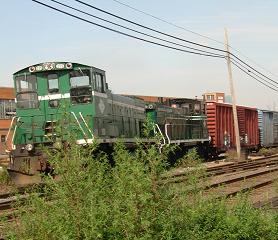In an excellent article entitled, “City’s goal is to breathe easy,” published this past February 28 in Newsday, reporter Emi Endo wrote:
“Last December [Mayor] Bloomberg announced 10 goals, including to ‘achieve the cleanest air of any big city in America.’
While some air pollutants have been reduced since 1990, the city falls short of federal Environmental Protection Agency standards … for fine particulate matter…
Dust and soot in the air, or particulate matter (PM2.5) – especially “fine” particles as tiny as 1/30th the width of a human hair – are believed to pose health risks because they can lodge deeply in the lungs, according to the EPA.
A recent 5-year New York University study showed a link between soot from diesel trucks in the South Bronx and wheezing and other asthma symptoms by measuring personal exposure to traffic pollution.”
We all know the Bronx is bad in terms of pollution. Now let’s turn our attention to West Maspeth. It is a heavily industrialized area containing several truck routes and a diesel train yard. St. Saviour’s sits adjacent to the former source of pollution and directly across the street from the latter.
The annual PM2.5 standard is 15 micrograms per cubic meter and the U.S. Environmental Protection Agency recently reduced the 24-hour PM2.5 standard to 35 micrograms per cubic meter which must be enforced by the NYS Department of Environmental Conservation (DEC). A recent air quality study performed at the request of the Juniper Park Civic Association by RTP Environmental Associates showed that samplings of PM2.5 levels over a two-hour late morning period at the St. Saviour’s site were double those simultaneously taken at the Maspeth Library, where the NYS DEC has placed stationary monitoring equipment. The Maspeth Library’s average reading was 13-15 micrograms per cubic meter between the hours of 10am and 12 noon, while those at St. Saviour’s were more than double those numbers, falling just below the legal limit during the same window of time.
RTP’s report concluded:
“…the PM2.5 values will likely violate the 24-hour PM2.5 standards as well as the annual standard at the St. Saviour’s site. These violations would be a result, in part, of the nearby traffic, railway and industrial activities.”
This partly explains why a section of West Maspeth is located within a recognized cancer hotspot. Asthma rates in this region are also higher than average. According to the Newsday article, there were 2,729 deaths in the New York metro region attributed to diesel fine particles in 1999, the most in the nation. In comparison, there were only 918 that same year in Los Angeles. A sizable portion of the deaths occurring in NYC no doubt happened right here in Maspeth.
The Grand Avenue Truck Bypass plan will soon be put into effect by the Department of Transportation. This initiative is aimed at getting trucks off of Grand Avenue, in the heart of Maspeth’s residential section, and onto Rust Street, which runs along the outskirts of town, through a mostly industrial area. This plan will benefit the vast majority of people living in Maspeth. However, there are people living near Rust Street, and the air that they breathe will soon be contaminated with emissions from more than 6,000 additional truck trips per day. That figure comes from a 2001 report completed by members of Community Board 5 and the Maspeth Chamber of Commerce.
However, according to a report released just this past January by Rep. Anthony Weiner, “Since 1998, truck traffic has increased nearly 30% on City roads and, by 2020, the number of miles traveled by trucks in New York City is projected to increase 83% citywide over the 1998 levels.” According to his numbers, it looks as though we can expect more like 8,000-9,000 additional truck trips per day.
If the Cross Harbor Tunnel gets built and an intermodal facility is constructed at the former Phelps Dodge site, we’ll be looking at more than 15,000 truck trips past St. Saviour’s per day, and that’s a conservative estimate!
The air is bad now at St. Saviour’s, but it will soon be much worse. Is it moral to allow new housing to be built along a potential cancer ribbon? Is allowing the destruction of the 1.5 acre green space that buffers surrounding homes from all this pollution part of the city’s 2030 plan to clean the air? We would appreciate it if Councilman Dennis Gallagher and Mayor Michael Bloomberg would answer those two questions. As we wait for them to do so, we won’t hold our breath. Unfortunately, the people living across the street from St. Saviour’s may soon have no choice but to hold theirs.



